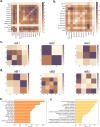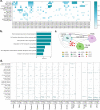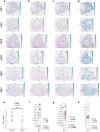An integrated study to decipher immunosuppressive cellular communication in the PDAC environment
- PMID: 37945567
- PMCID: PMC10636193
- DOI: 10.1038/s41540-023-00320-6
An integrated study to decipher immunosuppressive cellular communication in the PDAC environment
Abstract
Pancreatic ductal adenocarcinoma (PDAC) is one the most aggressive cancers and characterized by a highly rigid and immunosuppressive tumor microenvironment (TME). The extensive cellular interactions are known to play key roles in the immune evasion, chemoresistance, and poor prognosis. Here, we used the spatial transcriptomics, scRNA-seq, and bulk RNA-seq datasets to enhance the insights obtained from each to decipher the cellular communication in the TME. The complex crosstalk in PDAC samples was revealed by the single-cell and spatial transcriptomics profiles of the samples. We show that tumor-associated macrophages (TAMs) are the central cell types in the regulation of microenvironment in PDAC. They colocalize with the cancer cells and tumor-suppressor immune cells and take roles to provide an immunosuppressive environment. LGALS9 gene which is upregulated in PDAC tumor samples in comparison to healthy samples was also found to be upregulated in TAMs compared to tumor-suppressor immune cells in cancer samples. Additionally, LGALS9 was found to be the primary component in the crosstalk between TAMs and the other cells. The widespread expression of P4HB gene and its interaction with LGALS9 was also notable. Our findings point to a profound role of TAMs via LGALS9 and its interaction with P4HB that should be considered for further elucidation as target in the combinatory immunotherapies for PDAC.
© 2023. The Author(s).
Conflict of interest statement
The authors declare no competing interests.
Figures







References
MeSH terms
LinkOut - more resources
Full Text Sources
Medical
Research Materials
Miscellaneous

